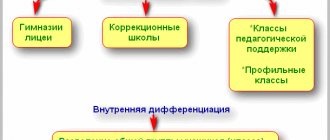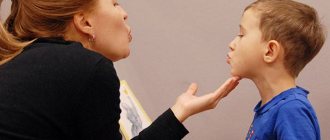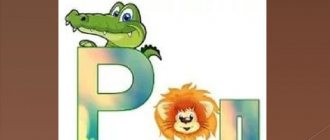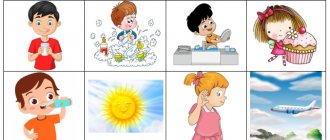Publications on speech therapy
And the presentation.
Target:
clarify and compare the articulation and sound of sounds [d', t'].
Objectives:
• teach children to differentiate sounds, enrich children's vocabulary;
• develop skills of syllabic analysis and synthesis; consolidate knowledge of language norms; • promote the development of coherent speech, higher mental processes (development of voluntary attention, auditory memory, motor skills). Learn to establish cause-and-effect relationships. • cultivate perseverance, hard work, and a sense of teamwork. Equipment:
for the teacher: presentation for the lesson, coloring books with a picture of a fairy, for students: workbooks, pens, pencils, counting sticks.
Progress of the lesson: 1. Organizational moment.
– Today we had fabulous guests come to our lesson, and you will find out who exactly by solving the crossword puzzle (slides 2,3).
Highlight the first letter of the first picture (flag – f) + F – The second letter of the name of the second picture (swan – e) + E – the last letter in the name of the third picture (sleigh – i) + I – From the resulting letters, make up the word + Fairies 2. Introduction with the heroes of the lesson and announcement of the topic.
– That’s right, the charming fairies Tinkerbell and Tintin came to our lesson (slide 4).
– They will help us learn to distinguish between their favorite sounds Дь and Ть (slide 5). 3. Pronunciation and characteristics of sounds (slide 6)
+дь ь + Sound Дь – consonant, voiced, soft, paired + Sound Ть – consonant, voiceless, soft, paired
4. The connection between sound and letters.
– Let’s write beautifully, neatly in a notebook the capital and lowercase letters Dd and Tt (sample on the board)
5. Development of phonemic awareness, game “Show the letter”
– I will name the words, and you, if you hear the sound D, make a roof over your head with your hands, it turns out letter D, if you hear the letter t, make a T with your hands (raise your left hand and place your right hand horizontally on top, you get the letter T). - So, we prepared our ears, we listen carefully: uncle, aunt, silence, delegate, model, tiger, dinosaur, dolphin, disco, rhyme, academy, Pinocchio, Thumbelina, girl, porcupine, kindergarten, airplane, pediatrician... - Well done! The next task is to connect objects with the corresponding letters with lines (slide 7).
6. Differentiation of sounds in words (work in notebooks)
– The fairies really liked this game, they had so much fun that they accidentally spilled magic powder on the words and their favorite letters flew away, let’s help them return the letters to their places (slide 8).
– Write down the words by filling in the missing letters. 7. Physical exercise “Fairies” (slide 9)
Fairies, fairies flew, sat quietly on the flowers.
They got up, sat down, got up, sat down, got up, flew again! They spun and twirled and sat down in their places! 8. Development of motor skills.
– Ting-ding and Ting-ting haven’t been home for a long time, and they really miss their home, let’s cheer them up and make their favorite castle out of sticks (slide 10).
9. Differentiation of sounds in the text
- Having seen their castle, they missed their parents even more and decided to write them a letter, but look what happened: they mixed up the letters D and T (slide 11).
Let's help them correct their mistakes, rewrite the letter in a notebook, correcting the mistakes they made: Dear Rotidels!
I write to you your dots Ting-ting and Ting-ding! Everything is fine with us, we came to Gosdi for a lesson, we are learning sounds and letters. We'll get to Tomoi soon! – Let’s check what we got (slide 12).
10. Homework
- Now you can send a letter, the parents of the fairies will be able to read it, in gratitude for this Tinker Bell and Tinkerkin give you their photographs, but unfortunately they are black and white, perform magic with colored pencils and turn black and white photographs in color.
11. Summary of the lesson
- Let us remind our guests what sounds we learned to distinguish during the lesson?
(T, d.) - Give a brief description of these sounds? (Ть - consonant, deaf, pronounced without the participation of the voice, soft. D - consonant, voiced, voice is involved in pronunciation, soft.) - Why did we learn to distinguish these sounds? +To write without errors. – Let's say goodbye to the fairies and wish them a happy journey! +….
Summary of an individual lesson on differentiating sounds t-d for children of the older group
Summary of an individual lesson on differentiation of sounds t-d for children of senior preschool age
Author: Yaskova Maria Mikhailovna teacher-speech therapist MADOU No. 21 “Iskorka”, Berdsk This development is designed for children of senior preschool age and is intended for speech therapists, preschool teachers institutions, parents. Goal: Correction of sound pronunciation and differentiation of sounds etc. Objectives: • To consolidate the correct pronunciation of the sound [k] in isolation, in a syllable, in words, in sentences, to learn to differentiate the sounds [t] and [d] in words. • Develop auditory and visual attention, phonemic awareness, thinking and memory. • Generate interest in speech therapy classes. Equipment: toy locomotive, dolls Danya and Tanya, object pictures (cat, kitten, dog, puppy, duck, duckling; locomotive, girl Tanya and boy Danya, Dunno), cards, audio recording with the sound of a passing locomotive.
Progress of the lesson:
I Organizational moment - Listen, what is this coming to us, what do you think? - That's right - a steam locomotive.
- Look at the station there are animals, name them. Subject pictures are laid out (cat, kitten, dog, puppy, duck, duckling). - These animals are rushing to the guys, help them get into the carriages. - Which animals would you put in one carriage, why? -What sound do you hear in all the words? - That's right, [k]. To pronounce this sound correctly, we will do articulatory gymnastics. II Articulation gymnastics Exercise “Smile-pipe”
.
— We smiled at the sunny day and played the pipe doo-doo. Exercise “Brushing your teeth” Exercise “Swing”
- After sitting on the swing and flying up to the sky.
III Characteristics of sound - How does the sound sound? (k-k-k) tell me where the tongue is when you pronounce the sound [k]. What position are your lips in? Now pronounce the sounds [t] and [d], tell me how they sound. IV Differentiation of sounds [t] and [d] in words. — While we were doing gymnastics, the animals arrived. Let's meet their friends. Dolls appear (boy - Danya and girl - Tanya).
— The boy’s name is Danya, and the girl’s name is Tanya (the pictures are laid out on the table). — What is the first sound in the name of a boy and a girl? Cards with words are laid out on the table (tom, trill, wheelbarrow, ink, dot, dacha, house, dacha, drill, shower). - Whose words do you think these are, give them to the guys. Explain your actions. - Tanya and Danya love to play, let's play with them. - If you like to play, you must quickly sit down and stand up. Hands to the sides, raise and rub your palms. And then a little ears, To listen better. V Differentiation of sounds in words that sound similar. — The guys have a friend Dunno (a picture is posted).
— He was given an assignment at school, but he got everything mixed up. Help Dunno understand the sentences. Listen to the sentences and pronounce them correctly. — Fruits are floating along the river. Rafts are maturing on the branches. — Draw water from the coil. Unwind the threads from the reel. — I'm reading a fat house. The architect draws a volume. VI Automation of sounds [k], [t] in different positions in words. - Repeat the words after me. zucchini lump Cossack cube heel tangle piece skate jamb doll sled tanks kids branches helmets masks mice caps flies gymnast guitar fleece spend give throw watch potatoes herring. VII Summary of the lesson - It’s time for Tanya and Dana to say goodbye to us. Did you like the games and tasks that we did together with the guys? What sounds did we encounter most often today?
We recommend watching:
Summary of GCD on speech therapy for the senior group Synopsis of a game lesson in the senior group on speech development Corrective - developmental GCD with a subgroup of children 5-6. Synopsis of an individual lesson on differentiating sounds S and Т for children 5-6 years old
Similar articles:
Musical lesson using logorhythmics in the senior group of a preschool educational institution
Summary of an integrated lesson on the topic “Animals” in the senior group
Lesson summary - travel for children of the senior group of preschool educational institutions on the topic: Birds
Summary of an integrated lesson on the topic “Space”. Senior group





